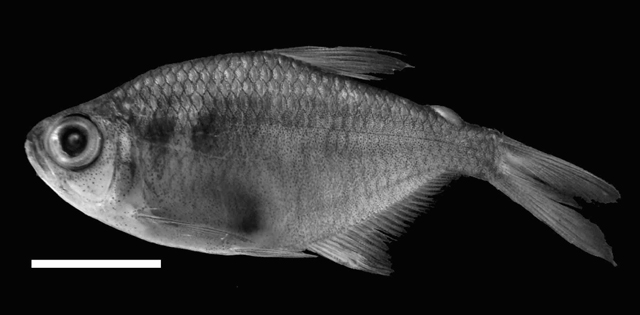| Characidae (Characins; tetras), subfamily: Stethaprioninae |
| 4.64 cm SL (male/unsexed) |
|
benthopelagic; freshwater |
| South America: middle section of the San Juan River drainage, Pacific versant of Colombia. |
|
Dorsal soft rays (total): 11-11; Vertebrae: 33-33. The presence of two humeral spots and the absence of caudal blotch separate this species from all congeners, except Hyphessobrycon bifasciatus, Hyphessobrycon balbus, Hyphessobrycon colombianus, Hyphessobrycon flammeus, Hyphessobrycon griemi, Hyphessobrycon itaparicensis, Hyphessobrycon savagei, Hyphessobrycon togoi and Hyphessobrycon weitzmanorum. Differs from those species in having the following characters: a higher number of branched pectoral-fin rays (12-13 vs. 10-11); a higher number of branched anal-fin rays (25-28 vs.17-24); a higher number of lateral scales (35-37 vs. 30-32); a higher number of scales between the lateral line and the base of the dorsal fin (eight vs. five to seven); a higher number of unbranched anal–fin rays (five vs. three to four unbranched); presence of three pairs of large bony hooks on anal fin of the mature males (vs. one or two pairs); a higher number of pored lateral-line scales (13-18 vs. 8-13, except Hyphessobrycon balbus with 11-22 and Hyphessobrycon togoi with 8-14) (Ref. 83523).
Description: Dorsal fin ii, 9; anal fin iv-v, 25-28; pectoral fin ii, 12-13; pelvic fin ii, 7 (Ref. 83523). |
| Based on 3 specimens, this species feeds mainly on insects (Ref. 83523). |
|
Data deficient (DD); Date assessed: 09 October 2014 Ref. (130435)
|
| harmless |
Source and more info: www.fishbase.org. For personal, classroom, and other internal use only. Not for publication.

